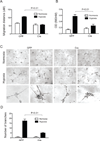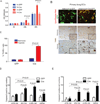Inhibition of ARNT severely compromises endothelial cell viability and function in response to moderate hypoxia
- PMID: 22484908
- PMCID: PMC3661274
- DOI: 10.1007/s10456-012-9269-x
Inhibition of ARNT severely compromises endothelial cell viability and function in response to moderate hypoxia
Abstract
Hypoxia inducible factor (HIF) is a master heterodimeric transcriptional regulator of oxygen (O(2)) homeostasis critical to proper angiogenic responses. Due to the distinctive coexpression of HIF-1α and HIF-2α subunits in endothelial cells, our goal was to examine the genetic elimination of HIF transcriptional activity in response to physiological hypoxic conditions by using a genetic model in which the required HIF-β subunit (ARNT, Aryl hydrocarbon Receptor Nuclear Translocator) to HIF transcriptional responses was depleted. Endothelial cells (ECs) and aortic explants were isolated from Arnt ( loxP/loxP ) mice and infected with Adenovirus-Cre/GFP or control-GFP. We observed that moderate levels of 2.5 % O(2) promoted vessel sprouting, growth, and branching in control aortic ring assays while growth from Adenovirus-Cre infected explants was compromised. Primary Adenovirus-Cre infected EC cultures featured adverse migration and tube formation phenotypes. Primary pulmonary or cardiac ARNT-deleted ECs also failed to proliferate and survive in response to 8 or 2.5 % O(2) and hydrogen peroxide treatment. Our data demonstrates that ARNT promotes EC migration and vessel outgrowth and is indispensible for the proliferation and preservation of ECs in response to the physiological environmental cue of hypoxia. Thus, these results demonstrate that ARNT plays a critical intrinsic role in ECs and support an important collaboration between HIF-1 and HIF-2 transcriptional activity in these cells.
Figures




Similar articles
-
The aryl hydrocarbon receptor nuclear translocator is an essential regulator of murine hematopoietic stem cell viability.Blood. 2015 May 21;125(21):3263-72. doi: 10.1182/blood-2014-10-607267. Epub 2015 Apr 8. Blood. 2015. PMID: 25855602 Free PMC article.
-
The role of the aryl hydrocarbon receptor nuclear translocator (ARNT) in hypoxic induction of gene expression. Studies in ARNT-deficient cells.J Biol Chem. 1996 Jun 21;271(25):15117-23. doi: 10.1074/jbc.271.25.15117. J Biol Chem. 1996. PMID: 8662957
-
Hypoxia influences the vascular expansion and differentiation of embryonic stem cell cultures through the temporal expression of vascular endothelial growth factor receptors in an ARNT-dependent manner.Stem Cells. 2010 Apr;28(4):799-809. doi: 10.1002/stem.316. Stem Cells. 2010. PMID: 20135683 Free PMC article.
-
Regulatory crosstalk and interference between the xenobiotic and hypoxia sensing pathways at the AhR-ARNT-HIF1α signaling node.Chem Biol Interact. 2014 Jul 25;218:82-8. doi: 10.1016/j.cbi.2014.05.001. Epub 2014 May 10. Chem Biol Interact. 2014. PMID: 24824450 Free PMC article. Review.
-
Regulation of HIF-1alpha at the transcriptional level.Curr Pharm Des. 2009;15(33):3844-52. doi: 10.2174/138161209789649420. Curr Pharm Des. 2009. PMID: 19671046 Review.
Cited by
-
Aryl Hydrocarbon Receptor Nuclear Translocator in Vascular Smooth Muscle Cells Is Required for Optimal Peripheral Perfusion Recovery.J Am Heart Assoc. 2018 Jun 1;7(11):e009205. doi: 10.1161/JAHA.118.009205. J Am Heart Assoc. 2018. PMID: 29858371 Free PMC article.
-
Heparanase released from mesenchymal stem cells activates integrin beta1/HIF-2alpha/Flk-1 signaling and promotes endothelial cell migration and angiogenesis.Stem Cells. 2015 Jun;33(6):1850-1862. doi: 10.1002/stem.1995. Stem Cells. 2015. PMID: 25754303 Free PMC article.
-
Loss of endothelial-ARNT in adult mice contributes to dampened circulating proangiogenic cells and delayed wound healing.Vasc Med. 2014 Dec;19(6):429-41. doi: 10.1177/1358863X14559588. Epub 2014 Nov 14. Vasc Med. 2014. PMID: 25398385 Free PMC article.
-
Crosstalk between the aryl hydrocarbon receptor and hypoxia-inducible factor 1α pathways in human islet models.Islets. 2025 Dec;17(1):2526871. doi: 10.1080/19382014.2025.2526871. Epub 2025 Jul 17. Islets. 2025. PMID: 40676831 Free PMC article.
-
Epicardial HIF signaling regulates vascular precursor cell invasion into the myocardium.Dev Biol. 2013 Apr 15;376(2):136-49. doi: 10.1016/j.ydbio.2013.01.026. Epub 2013 Feb 4. Dev Biol. 2013. PMID: 23384563 Free PMC article.
References
-
- Cockman ME, Masson N, Mole DR, Jaakkola P, Chang GW, Clifford SC, Maher ER, Pugh CW, Ratcliffe PJ, Maxwell PH. Hypoxia inducible factor-alpha binding and ubiquitylation by the von hippel-lindau tumor suppressor protein. J Biol Chem. 2000;275(33):25733–25741. - PubMed
-
- Epstein JM, Gleadle AC, McNeill LA, Hewitson KS, O'Rourke J, Mole DR, Mukherji M, Metzen E, Wilson MI, Dhanda A, Tian YM, Masson N, Hamilton DL, Jaakkola P, Barstead R, Hodgkin J, Maxwell PH, Pugh CW, Schofield CJ, Ratcliffe PJ. C. Elegans egl-9 and mammalian homologs define a family of dioxygenases that regulate hif by prolyl hydroxylation. Cell. 2001;107(1):43–54. - PubMed
Publication types
MeSH terms
Substances
Grants and funding
LinkOut - more resources
Full Text Sources

